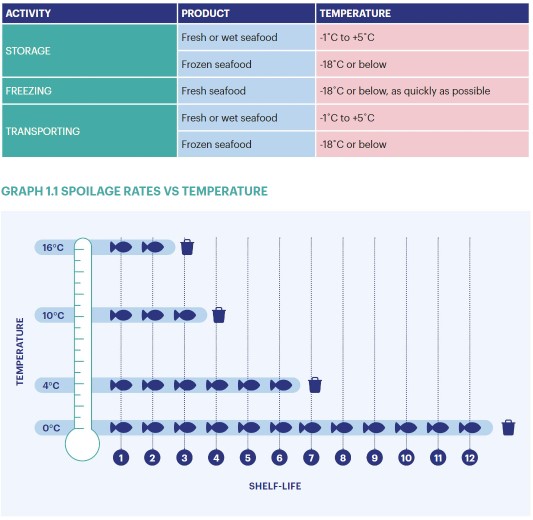Ageing fish has been part of Japanese cuisine for centuries, however traditionally this was done using ‘wet’ ageing (which seals fish from the elements before ageing).
Dry-ageing, in contrast, has really only become a trend in the seafood world in more recent years. Pioneered by some of Australia’s best chefs – most famously, Josh Niland – the method applies techniques traditionally used to age red meat, to fish.
As more and more chefs follow Niland’s lead, and more and more home cooks investigate dry-ageing for themselves, we thought now was the perfect opportunity to explain a bit more about it.
WHAT IS DRY-AGEING?
While every chef has a slightly different method, the process of dry-ageing fish generally involves storing scaled and gutted fish in specialised refrigerated environments (often hanging from large, stainless-steel hooks) for up to two months, to slowly remove moisture from the flesh.
WHAT ARE THE BENEFITS OF DRY-AGEING?
Firstly, the protein breakdown that occurs during dry-ageing improves flavour complexity, as the acids responsible for umami flavour are released. This enzyme also acts on the connective tissues of the fish, loosening muscle structure and therefore improving the texture and mouthfeel of the fish... How cool is that?
The other impact dry-ageing has is to draw moisture out of the fish. This might not sound appetising, but we’re here to change your mind. Drawing out moisture not only helps to concentrate the flavour of the fish, but it also results in super crispy skin when you get to cooking.
Yep, that’s why Josh Niland’s fish fillets always look like that.
WHAT KINDS OF FISH CAN BE DRY-AGED?
Like any more intense cooking method, it’s best to use fish species that can hold their own, in both oil content and muscle density.
The best options are Tuna, Mackerels (especially Spanish Mackerel), and Swordfish. Josh Niland also uses Murray Cod quite a bit, which is a great option due to its year-round availability and sustainability (as an aquaculture species).
These fish are oily enough that they won’t become dry during the ageing process, and firm enough that their muscle tissue won’t degrade too quickly.
CAN I DRY-AGE FISH AT HOME?
Now for the bad news. The kind of equipment required to dry-age fish safely most likely does not exist in your home kitchen.
For dry-ageing to be successful, the fish must be skillfully scaled and gutted, kept at a constant temperature (between 1 and 2 degrees Celsius) and low humidity, for a long period of time (separate to other food storage), and monitored extremely carefully to ensure it doesn’t spoil.
The types of fish that are good for dry-ageing (tuna, Sardines, Mackerels, and Swordfish) are also the same types that are prone to histamine poisoning (which can occur if temperature isn’t perfectly controlled), so you’ve got to be extra careful.
It’s also extremely important to process fish with the top of the top hygiene practices: we’re talking perfectly clean hands, tools, and surfaces.
But... all is not lost!
There’s no reason why you can’t bring the concept of ageing fish into your everyday life: it can improve your seafood eating experience, save you money, and open up a whole bunch of new recipe options to you.
The first principle we encourage you to embrace is that there’s no need to eat fish on the same day you bought it, as long as you know for sure how fresh it is!
While at first it might make you nervous, there’s nothing wrong with keeping fresh fish for 3-5 days after purchase, as long as you’re buying from a trusted source, and following best storage practices.
Our Seafood Handling Guidelines are the bible for seafood suppliers, retailers, wholesalers, and processors all over Australia. This mammoth document provides guidelines for the whole industry to follow, to ensure the maximum quality and freshness of their seafood product... And there’s no reason why you can’t use them too!
Because we’re generous, we’ll save you the trouble of reading the whole thing. The info you need is on page 9 (below).
Basically, what this table shows is that the longer your fish is kept at 0 degrees Celsius, the longer its shelf life will be. This means that in theory, if the fisher, us at Sydney Fish Market, and the wholesaler or retailer have all handled the product according to these guidelines, you could get up to 12 days of shelf life out of a fish. Wild, right?
What it means in practice is that if you’re buying from a trusted fishmonger (who can assure you of the quality and freshness of their product), then storing your fish correctly (in the coldest part of your fridge), there’s no reason why you can’t get 3 days of shelf life out of it.
There are a few important tips to remember here:
1. Use your senses when shopping.
Get up close and personal to make sure the fish you’re buying is fresh in the first instance. That means looking for glossy, shiny skin or scales and lustrous, undamaged flesh, and sniffing for a fresh, oceanic smell.
2. Chat to your fishmonger.
Good fishmongers won’t have a problem telling you exactly where each fish in their window is from, and approximately when it was caught. You’re looking for local species wherever possible (as they’ve had less travel time to get to you), and ideally for product caught in the past 2-3 days.
3. Transport your fish correctly.
Remember that funky little table from the Seafood Handling Guidelines? That shows the singular importance of keeping your seafood cold. Use a cooler bag and ask your fishmonger to pack some ice with your purchase to make sure it stays between 1 and 5 degrees Celsius on the journey.
4. Use your senses at home.
The organoleptic (now there’s a word!) assessments don’t stop once you’ve got your fish home. Always give it a good examination and sniff before you cook with it. Trust us: your nose will tell you immediately if something is wrong.
We hope this cleared up some misconceptions about the shelf life of fish, and what the big deal with ageing it is. Let us know through our social channels if we taught you something new!




